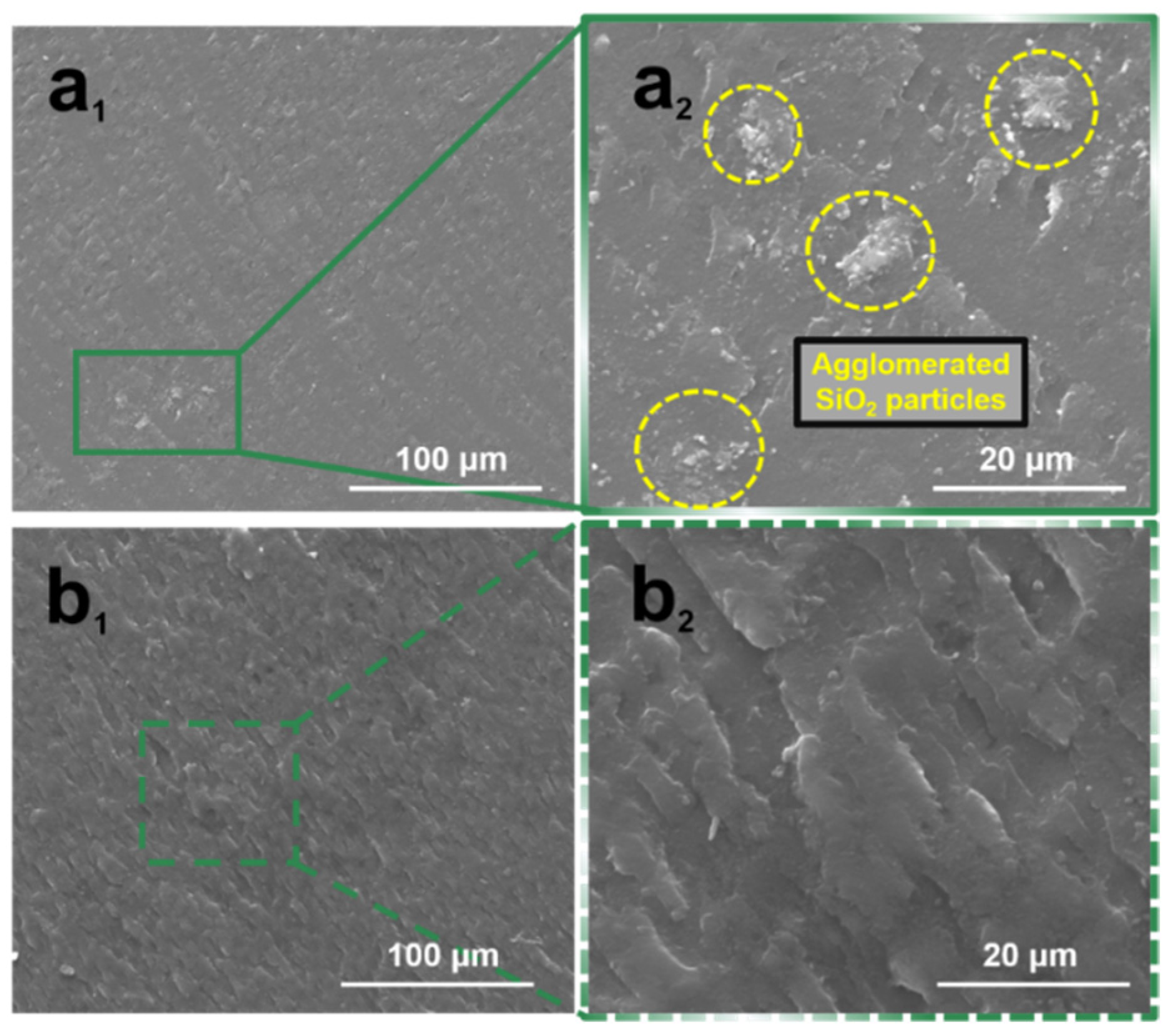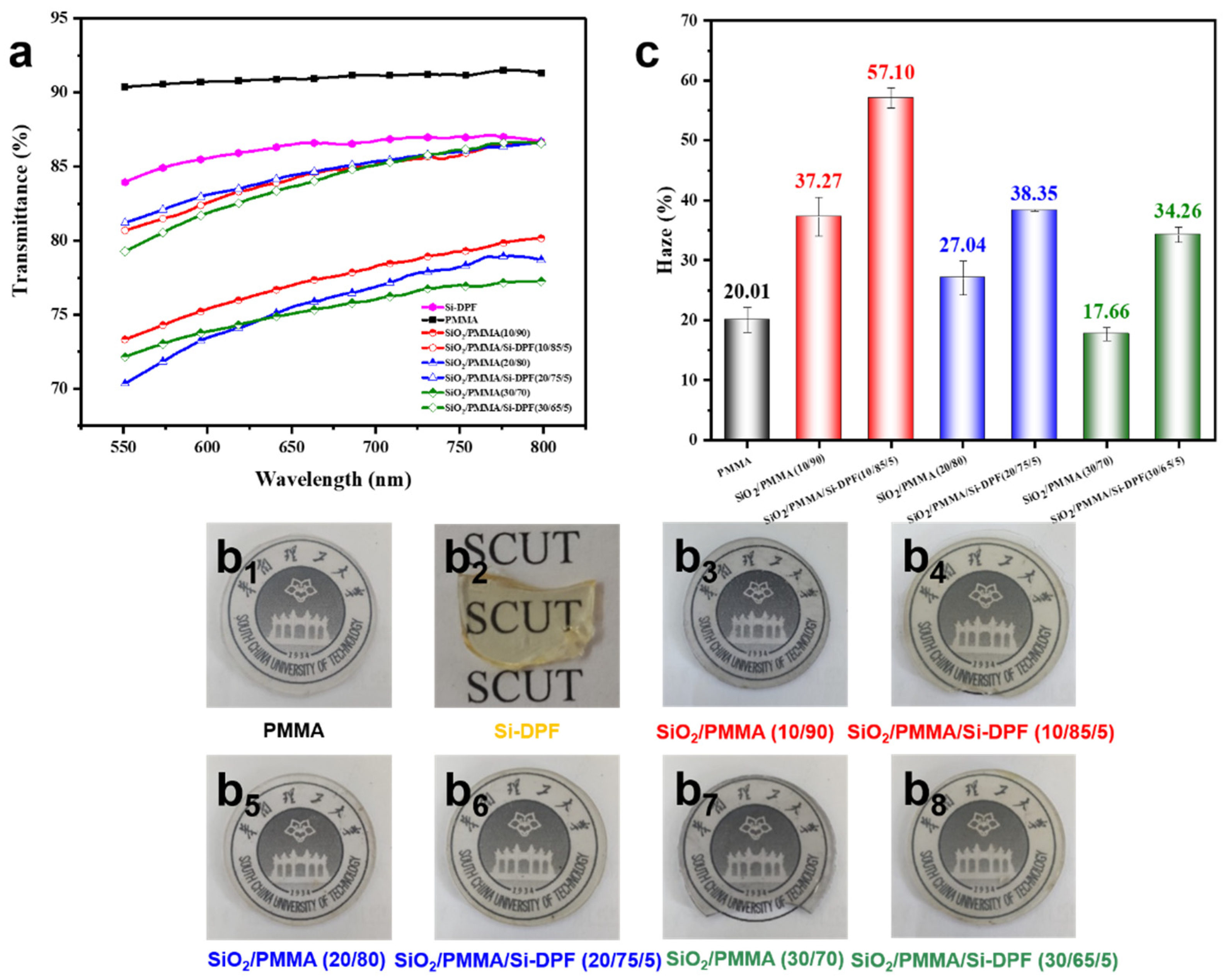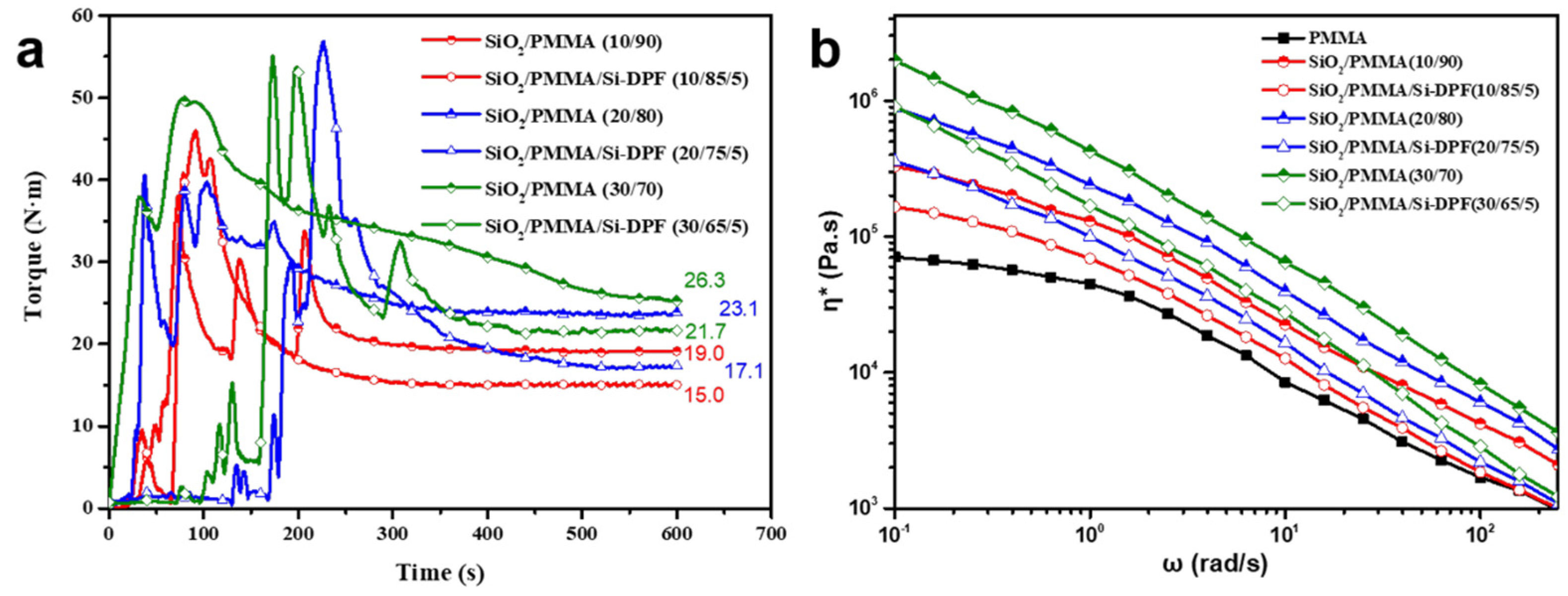The Fabrication of High-Hardness and Transparent PMMA-Based Composites by an Interface Engineering Strategy
Abstract
1. Introduction
2. Results and Discussion
2.1. Phase Morphology
2.2. Surface Hardness
2.3. Optical Properties
2.4. Processability
2.5. Toughness
3. Experimental
3.1. Main Materials
3.2. Fabrication of SiO2/PMMA Composites
3.3. Analysis and Characterization
4. Conclusions
Author Contributions
Funding
Institutional Review Board Statement
Informed Consent Statement
Data Availability Statement
Conflicts of Interest
References
- Wang, L.; Yoon, M.-H.; Lu, G.; Yang, Y.; Facchetti, A.; Marks, T.J. High-Performance Transparent Inorganic–Organic Hybrid Thin-Film n-Type Transistors. Nat. Mater. 2006, 5, 893–900. [Google Scholar] [CrossRef] [PubMed]
- Lü, C.; Yang, B. High Refractive Index Organic–Inorganic Nanocomposites: Design, Synthesis and Application. J. Mater. Chem. 2009, 19, 2884–2901. [Google Scholar] [CrossRef]
- Maeda, S.; Fujita, M.; Idota, N.; Matsukawa, K.; Sugahara, Y. Preparation of Transparent Bulk TiO2/PMMA Hybrids with Improved Refractive Indices Via an in Situ Polymerization Process Using TiO2 Nanoparticles Bearing PMMA Chains Grown by Surface-Initiated Atom Transfer Radical Polymerization. ACS Appl. Mater. Interfaces 2016, 8, 34762–34769. [Google Scholar] [CrossRef] [PubMed]
- Almaral-Sánchez, J.L.; Rubio, E.; Mendoza-Galván, A.; Ramirez-Bon, R. Red Colored Transparent PMMA–SiO2 Hybrid Films. J. Phys. Chem. Solids 2005, 66, 1660–1667. [Google Scholar] [CrossRef]
- Palkovits, R.; Althues, H.; Rumplecker, A.; Tesche, B.; Dreier, A.; Holle, U.; Fink, G.; Cheng, C.H.; Shantz, D.F.; Kaskel, S. Polymerization of w/o Microemulsions for the Preparation of Transparent SiO2/PMMA Nanocomposites. Langmuir 2005, 21, 6048–6053. [Google Scholar] [CrossRef]
- Sugimoto, H.; Daimatsu, K.; Nakanishi, E.; Ogasawara, Y.; Yasumura, T.; Inomata, K. Preparation and Properties of Poly (Methylmethacrylate)–Silica Hybrid Materials Incorporating Reactive Silica Nanoparticles. Polymer 2006, 47, 3754–3759. [Google Scholar] [CrossRef]
- Tadano, T.; Zhu, R.; Suzuki, S.; Hoshi, T.; Sasaki, D.; Hagiwara, T.; Sawaguchi, T. Thermal Degradation of Transparent Poly(Methyl Methacrylate)/Silica Nanoparticle Hybrid Films. Polym. Degrad. Stabil. 2014, 109, 7–12. [Google Scholar] [CrossRef]
- Fabre-Francke, I.; Berrebi, M.; Lavédrine, B.; Fichet, O. Hybrid PMMA Combined with Polycarbonate inside Interpenetrating Polymer Network Architecture for Development of New Anti-Scratch Glass. Mater. Today Commun. 2019, 21, 100582. [Google Scholar] [CrossRef]
- Melgoza-Ramírez, M.L.; Ramírez-Bon, R. Microstructural Comparison between PMMA-SiO2 and PMMA-TiO2 Hybrid Systems Using Eu3+ as Ion-Probe Luminescence. J. Non-Cryst. Solids. 2020, 544, 120167. [Google Scholar] [CrossRef]
- Zhang, X.J.; Zhang, X.Y.; Zhu, B.S.; Qian, C. Effect of Nano ZrO2 on Flexural Strength and Surface Hardness of Polymethylmethacrylate. Shanghai J. Stomatol. 2011, 20, 358–363. [Google Scholar]
- Asgharzadeh Shirazi, H.; Ayatollahi, M.; Navidbakhsh, M.; Asnafi, A. New Insights into the Role of Al2O3 Nano-Supplements in Mechanical Performance of PMMA and PMMA/HA Bone Cements Using Nanoindentation and Nanoscratch Measurements. Mater. Technol. 2021, 36, 212–220. [Google Scholar] [CrossRef]
- Chen, X.; Xu, T.; Lei, H.; Tan, L.; Yang, L. Multifunctional Nano-ZnO/PMMA Composites with High Transparency Prepared by One-Step in Situ Polymerization. Polym. Compos. 2019, 40, 657–663. [Google Scholar] [CrossRef]
- Cao, B.; Zhou, Y.; Wu, Y.; Cai, J.; Guan, X.; Liu, S.; Zhao, J.; Zhang, M. Simultaneous Improvement of Processability and Toughness of Highly Filled MH/LLDPE Composites by Using Fluorine-Containing Flow Modifiers. Compos. Part A-Appl. Sci. 2020, 134, 105900. [Google Scholar] [CrossRef]
- Li, B.; Yuan, H.; Zhang, Y. Transparent PMMA-Based Nanocomposite Using Electrospun Graphene-Incorporated PA-6 Nanofibers as the Reinforcement. Compos. Sci. Technol. 2013, 89, 134–141. [Google Scholar] [CrossRef]
- Tian, Z.R.; Voigt, J.A.; Liu, J.; McKenzie, B.; McDermott, M.J.; Rodriguez, M.A.; Konishi, H.; Xu, H. Complex and Oriented ZnO Nanostructures. Nat. Mater. 2003, 2, 821–826. [Google Scholar] [CrossRef] [PubMed]
- Djurišić, A.B.; Leung, Y.H. Optical Properties of ZnO Nanostructures. Small 2006, 2, 944–961. [Google Scholar] [CrossRef]
- Shchegolkov, A.V.; Jang, S.-H.; Shchegolkov, A.V.; Rodionov, Y.V.; Glivenkova, O.A. Multistage Mechanical Activation of Multilayer Carbon Nanotubes in Creation of Electric Heaters with Self-Regulating Temperature. Materials 2021, 14, 4654. [Google Scholar] [CrossRef]
- Göldel, A.; Marmur, A.; Kasaliwal, G.R.; Pötschke, P.; Heinrich, G. Shape-Dependent Localization of Carbon Nanotubes and Carbon Black in an Immiscible Polymer Blend During Melt Mixing. Macromolecules 2011, 44, 6094–6102. [Google Scholar] [CrossRef]
- Yu, S.; Oh, K.H.; Hong, S.H. Effects of Silanization and Modification Treatments on the Stiffness and Toughness of BF/SEBS/PA6, 6 Hybrid Composites. Compos. Part B Eng. 2019, 173, 106922. [Google Scholar] [CrossRef]
- Cao, B.; Wang, O.; Cai, J.; Xie, W.; Liu, S.; Zhao, J. Silicone/Fluorine-Functionalized Flow Modifier with Low Surface Energy for Improving Interfaces in Highly Filled Composites. Compos. Sci. Technol. 2021, 214, 108994. [Google Scholar] [CrossRef]
- Lü, C.; Cheng, Y.; Liu, Y.; Liu, F.; Yang, B. A Facile Route to ZnS–Polymer Nanocomposite Optical Materials with High Nanophase Content Via γ-Ray Irradiation Initiated Bulk Polymerization. Adv. Mater. 2006, 18, 1188–1192. [Google Scholar] [CrossRef]
- Rueda, M.M.; Auscher, M.-C.; Fulchiron, R.; Perie, T.; Martin, G.; Sonntag, P.; Cassagnau, P. Rheology and Applications of Highly Filled Polymers: A Review of Current Understanding. Prog. Polym. Sci. 2017, 66, 22–53. [Google Scholar] [CrossRef]
- Zhu, B.; Wang, Y.; Liu, H.; Ying, J.; Liu, C.; Shen, C. Effects of Interface Interaction and Microphase Dispersion on the Mechanical Properties of PCL/PLA/MMT Nanocomposites Visualized by Nanomechanical Mapping. Compos. Sci. Technol. 2020, 190, 108048. [Google Scholar] [CrossRef]
- Chen, R.; Zhang, Y.; Xie, Q.; Chen, Z.; Ma, C.; Zhang, G. Transparent Polymer-Ceramic Hybrid Antifouling Coating with Superior Mechanical Properties. Adv. Funct. Mater. 2021, 31, 2011145. [Google Scholar] [CrossRef]
- Jamaluddin, N.; Hsu, Y.-I.; Asoh, T.-A.; Uyama, H. Optically Transparent and Toughened Poly (Methyl Methacrylate) Composite Films with Acylated Cellulose Nanofibers. ACS Omega 2021, 6, 10752–10758. [Google Scholar] [CrossRef]
- Wildner, W.; Drummer, D. The Mechanical and Optical Properties of Injection-Moulded PMMA, Filled with Glass Particles of a Matching Refractive Index. Polym. Polym. Compos. 2017, 25, 453–462. [Google Scholar] [CrossRef]
- Ma, Y.; Gou, T.; Feng, C.; Li, J.; Li, Y.; Huang, J.; Li, R.; Zhang, Z.; Gao, X. Facile Fabrication of Biomimetic Films with the Microdome and Tapered Nanonipple Hierarchical Structure Possessing High Haze, High Transmittance, Anti-Fouling and Moisture Self-Cleaning Functions. Chem. Eng. J. 2021, 404, 127101. [Google Scholar] [CrossRef]
- Kim, D.H.; Dudem, B.; Jung, J.W.; Yu, J.S. Boosting Light Harvesting in Perovskite Solar Cells by Biomimetic Inverted Hemispherical Architectured Polymer Layer with High Haze Factor as an Antireflective Layer. ACS Appl. Mater. Inter. 2018, 10, 13113–13123. [Google Scholar] [CrossRef]
- Fang, Z.; Zhu, H.; Yuan, Y.; Ha, D.; Zhu, S.; Preston, C.; Chen, Q.; Li, Y.; Han, X.; Lee, S. Novel Nanostructured Paper with Ultrahigh Transparency and Ultrahigh Haze for Solar Cells. Nano Lett. 2014, 14, 765–773. [Google Scholar] [CrossRef]
- Wu, G.; Guo, S.; Yin, Y.; Sun, G.; Zhong, Y.; You, B. Hollow Microspheres of SiO2/PMMA Nanocomposites: Preparation and Their Application in Light Diffusing Films. J. Inorg. Organomet. Polym. 2018, 28, 2701–2713. [Google Scholar] [CrossRef]






| Samples | Strategy | Filler Loading [wt%] | Transmittance [%, 760 nm] | Surface Hardness Enhancement [%] | Year [Ref] |
|---|---|---|---|---|---|
| SiO2/PMMA | In situ polymerization | 37.5 | 90 | 80.0 | 2005 [4] |
| SiO2/PMMA | 4 | 78 | - | 2005 [5] | |
| ZnO/PMMA | 5 | 65 | - | 2018 [12] | |
| SiO2/PMMA | ≈3 | 88 | - | 2020 [9] | |
| TiO2/PMMA | ≈3 | 87 | - | 2020 [9] | |
| SiO2/PMMA | Modified polymerization | 50 | 89.5 | 85.2 | 2006 [6] |
| SiO2/PMMA | 13.5 | 90 | - | 2019 [8] | |
| ZrO2/PMMA | Hot compression | 1.5 | - | 12.3 | 2011 [10] |
| Al2O3/PMMA | 3 | - | 29.8 | 2020 [11] | |
| SiO2/PMMA | Solution blending | 9.1 | 72 | - | 2014 [7] |
| SiO2/PMMA | Melt blending | 30 | 87.2 | 95.5 | This work |
| Samples | SiO2 (g) | PMMA (g) | Si-DPF (g) |
|---|---|---|---|
| SiO2/PMMA (10/90) | 10 | 90 | - |
| SiO2/PMMA/Si-DPF (10/85/5) | 10 | 85 | 5 |
| SiO2/PMMA (20/80) | 20 | 80 | - |
| SiO2/PMMA/Si-DPF (20/75/5) | 20 | 75 | 5 |
| SiO2/PMMA (30/70) | 30 | 70 | - |
| SiO2/PMMA/Si-DPF (30/65/5) | 30 | 65 | 5 |
Disclaimer/Publisher’s Note: The statements, opinions and data contained in all publications are solely those of the individual author(s) and contributor(s) and not of MDPI and/or the editor(s). MDPI and/or the editor(s) disclaim responsibility for any injury to people or property resulting from any ideas, methods, instructions or products referred to in the content. |
© 2022 by the authors. Licensee MDPI, Basel, Switzerland. This article is an open access article distributed under the terms and conditions of the Creative Commons Attribution (CC BY) license (https://creativecommons.org/licenses/by/4.0/).
Share and Cite
Cao, B.; Wu, P.; Zhang, W.; Liu, S.; Zhao, J. The Fabrication of High-Hardness and Transparent PMMA-Based Composites by an Interface Engineering Strategy. Molecules 2023, 28, 304. https://doi.org/10.3390/molecules28010304
Cao B, Wu P, Zhang W, Liu S, Zhao J. The Fabrication of High-Hardness and Transparent PMMA-Based Composites by an Interface Engineering Strategy. Molecules. 2023; 28(1):304. https://doi.org/10.3390/molecules28010304
Chicago/Turabian StyleCao, Bo, Peng Wu, Wenxiang Zhang, Shumei Liu, and Jianqing Zhao. 2023. "The Fabrication of High-Hardness and Transparent PMMA-Based Composites by an Interface Engineering Strategy" Molecules 28, no. 1: 304. https://doi.org/10.3390/molecules28010304
APA StyleCao, B., Wu, P., Zhang, W., Liu, S., & Zhao, J. (2023). The Fabrication of High-Hardness and Transparent PMMA-Based Composites by an Interface Engineering Strategy. Molecules, 28(1), 304. https://doi.org/10.3390/molecules28010304




